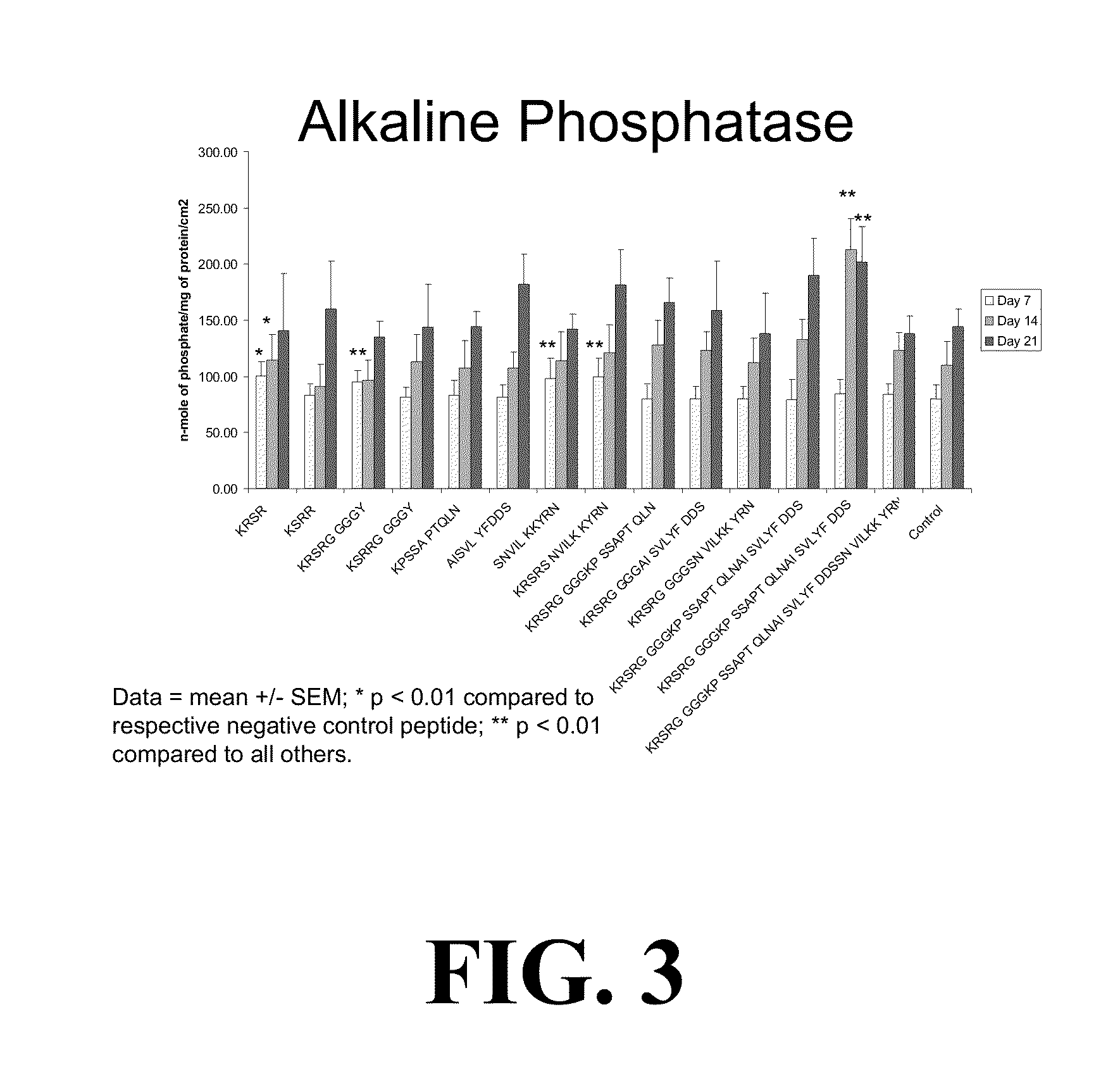Biomimetic peptides for bone augmentation
a biomimetic peptide and bone augmentation technology, applied in the field of synthetic peptides, can solve the problems of inability to compare natural bone, mechanical properties, ductility and toughness of conventional biosubstitutes, and failure of metal materials under long-term physiological loading, and achieve the effects of promoting the adhesion and density of corresponding tissue cells, and promoting the adhesion of osteoblasts to said surfa
- Summary
- Abstract
- Description
- Claims
- Application Information
AI Technical Summary
Benefits of technology
Problems solved by technology
Method used
Image
Examples
example 1
Development and Testing of Peptides for Bone Augmentation Applications
[0077]In the context of early testing of manufacturing, we have produced several novel peptide sequences that have better in vitro and in vivo responses over peptides currently available. Direct application of the peptide sequences (shown in Table 1) can be used in orthopedic, spine and dental use to promote implants and hard tissue interaction.
[0078]For example, in one series of studies we designed 14 peptide sequences for potential use in bone augmentation applications, as shown in Table 1 below.
TABLE 1SEQIDNO:PEPTIDE SEQUENCE 1KRSR 2KSRR 3KRSRG GGGY 4KSRRG GGGY 5KPSSA PTQLN 6AISVL YFDDS 7SNVIL KKYRN 8KRSRS NVILK KYRN 9KRSRG GGGKP SSAPT QLN10KRSRG GGGAI SVLYF DDS11KRSRG GGGSN VILKK YRN12KRSRG GGGKP SSAPT QLNAI SVLYF DDS13KRSRG GGGAI SVLYF DDSSN VILKK YRN14KRSRG GGGKP SSAPT QLNAI SVLYF DDSSN VILKK YRN
[0079]The peptide sequences of Table 1 contain components of KRSR-based sequences and BMP-7 fragments, as well as ...
example 2
Peptide Conjugation / Elution Strategy
[0081]As shown in FIG. 7, peptide conjugation and elution strategies were identified for PLGA and HA based materials. It is possible that one can achieve a peptide elution profile ranging from hours (quick) to days (Medium to longer).
example 3
Peptide Concentration Selection
[0082]Based on our preliminary animal experiment with PIG models, and our understanding, we will use a peptide concentration of in the range of 10−12 M to 10−6 M for cellular response. Weight of each peptide is labeled by manufacturer on every vial. Based on that weight, we should able to prepare the desired concentration.
PUM
| Property | Measurement | Unit |
|---|---|---|
| Fraction | aaaaa | aaaaa |
| Composition | aaaaa | aaaaa |
| Concentration | aaaaa | aaaaa |
Abstract
Description
Claims
Application Information
 Login to View More
Login to View More - R&D Engineer
- R&D Manager
- IP Professional
- Industry Leading Data Capabilities
- Powerful AI technology
- Patent DNA Extraction
Browse by: Latest US Patents, China's latest patents, Technical Efficacy Thesaurus, Application Domain, Technology Topic, Popular Technical Reports.
© 2024 PatSnap. All rights reserved.Legal|Privacy policy|Modern Slavery Act Transparency Statement|Sitemap|About US| Contact US: help@patsnap.com










